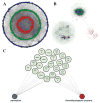Predicting Adverse Drug Effects from Literature- and Database-Mined Assertions
- PMID: 29876834
- PMCID: PMC6212308
- DOI: 10.1007/s40264-018-0688-5
Predicting Adverse Drug Effects from Literature- and Database-Mined Assertions
Abstract
Introduction: Given that adverse drug effects (ADEs) have led to post-market patient harm and subsequent drug withdrawal, failure of candidate agents in the drug development process, and other negative outcomes, it is essential to attempt to forecast ADEs and other relevant drug-target-effect relationships as early as possible. Current pharmacologic data sources, providing multiple complementary perspectives on the drug-target-effect paradigm, can be integrated to facilitate the inference of relationships between these entities.
Objective: This study aims to identify both existing and unknown relationships between chemicals (C), protein targets (T), and ADEs (E) based on evidence in the literature.
Materials and methods: Cheminformatics and data mining approaches were employed to integrate and analyze publicly available clinical pharmacology data and literature assertions interrelating drugs, targets, and ADEs. Based on these assertions, a C-T-E relationship knowledge base was developed. Known pairwise relationships between chemicals, targets, and ADEs were collected from several pharmacological and biomedical data sources. These relationships were curated and integrated according to Swanson's paradigm to form C-T-E triangles. Missing C-E edges were then inferred as C-E relationships.
Results: Unreported associations between drugs, targets, and ADEs were inferred, and inferences were prioritized as testable hypotheses. Several C-E inferences, including testosterone → myocardial infarction, were identified using inferences based on the literature sources published prior to confirmatory case reports. Timestamping approaches confirmed the predictive ability of this inference strategy on a larger scale.
Conclusions: The presented workflow, based on free-access databases and an association-based inference scheme, provided novel C-E relationships that have been validated post hoc in case reports. With refinement of prioritization schemes for the generated C-E inferences, this workflow may provide an effective computational method for the early detection of potential drug candidate ADEs that can be followed by targeted experimental investigations.
Conflict of interest statement
Mary La, Alexander Sedykh, Denis Fourches, Eugene Muratov, and Alexander Tropsha declare no conflict of interest that are directly relevant to the content of this study.
Figures






Similar articles
-
Adverse drug events: database construction and in silico prediction.J Chem Inf Model. 2013 Apr 22;53(4):744-52. doi: 10.1021/ci4000079. Epub 2013 Apr 8. J Chem Inf Model. 2013. PMID: 23521697
-
Leveraging graph topology and semantic context for pharmacovigilance through twitter-streams.BMC Bioinformatics. 2016 Oct 6;17(Suppl 13):335. doi: 10.1186/s12859-016-1220-5. BMC Bioinformatics. 2016. PMID: 27766937 Free PMC article.
-
Data mining methodology for response to hypertension symptomology-application to COVID-19-related pharmacovigilance.Elife. 2021 Nov 23;10:e70734. doi: 10.7554/eLife.70734. Elife. 2021. PMID: 34812146 Free PMC article.
-
Novel data-mining methodologies for adverse drug event discovery and analysis.Clin Pharmacol Ther. 2012 Jun;91(6):1010-21. doi: 10.1038/clpt.2012.50. Clin Pharmacol Ther. 2012. PMID: 22549283 Free PMC article. Review.
-
Improving postapproval drug safety surveillance: getting better information sooner.Annu Rev Pharmacol Toxicol. 2015;55:75-87. doi: 10.1146/annurev-pharmtox-011613-135955. Epub 2014 Sep 25. Annu Rev Pharmacol Toxicol. 2015. PMID: 25292435 Free PMC article. Review.
Cited by
-
Machine Learning Techniques for Predicting Drug-Related Side Effects: A Scoping Review.Pharmaceuticals (Basel). 2024 Jun 17;17(6):795. doi: 10.3390/ph17060795. Pharmaceuticals (Basel). 2024. PMID: 38931462 Free PMC article.
References
-
- Aronson JK. Distinguishing hazards and harms, adverse drug effects and adverse drug reactions: Implications for drug development, clinical trials, pharmacovigilance, biomarkers, and monitoring. Drug Saf. 2013;36:147–53. - PubMed
-
- Shepherd G, Mohorn P, Yacoub K, May DW. Adverse drug reaction deaths reported in United States vital statistics, 1999–2006. Ann Pharmacother. 2012;46:169–75. - PubMed
-
- Suh DC, Woodall BS, Shin SK, Hermes-De Santis ER. Clinical and economic impact of adverse drug reactions in hospitalized patients. Ann Pharmacother. 2000;34:1373–9. - PubMed
-
- Agency for Healthcare Research and Quality. Reducing and Preventing Adverse Drug Events To Decrease Hospital Costs [Internet] AHRQ Arch; [Accessed 02 Apr 2014]. Available from: https://archive.ahrq.gov/research/findings/factsheets/errors-safety/ader....
-
- Ninan B, Wertheimer A. Withdrawing Drugs in the U.S. Versus Other Countries. [Accessed 19 Apr 2018];Innov Pharm [Internet] 2012 3(3) Article 87. Available from: https://pubs.lib.umn.edu/index.php/innovations/article/view/269/263.
Publication types
MeSH terms
Substances
Grants and funding
LinkOut - more resources
Full Text Sources
Other Literature Sources
Medical

